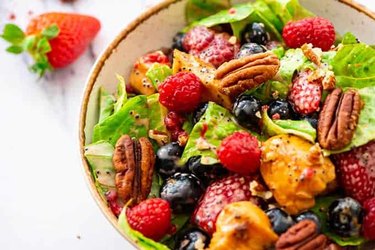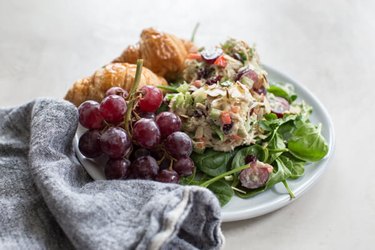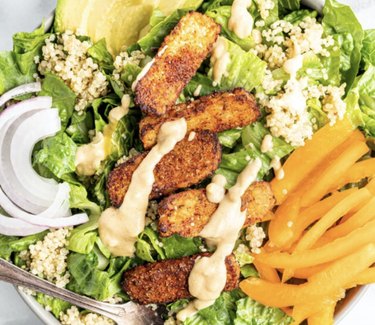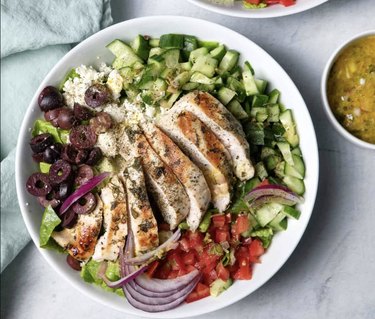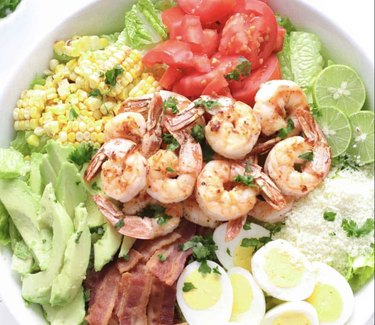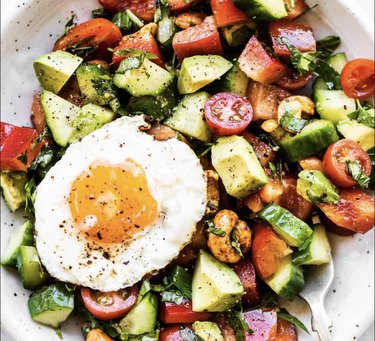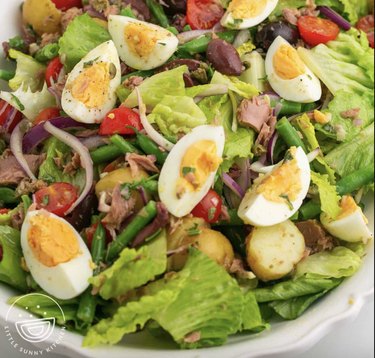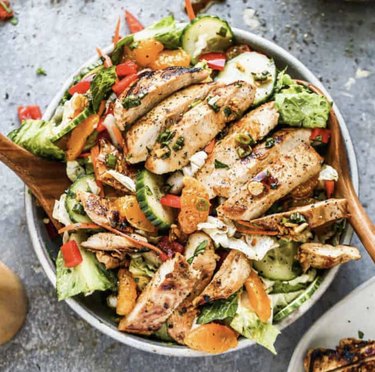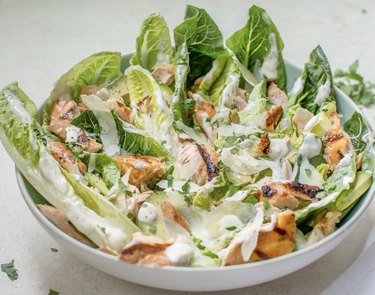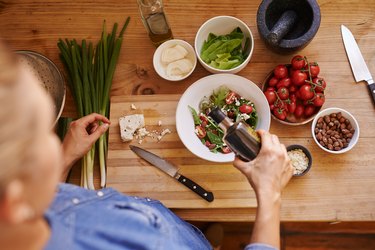
Building weight loss-friendly meals means striking a balance between foods that'll fill you up and ones that are relatively low in calories. While there are lots of options that can potentially fit the bill, high-protein salads are a particularly good choice.
"Salads that are high in lean protein can be a good choice when you're trying to lose weight," says Erin Palinksi-Wade, RD, CDE, registered dietitian, certified diabetes educator and author of the 2 Day Diabetes Diet.
Video of the Day
Video of the Day
Here's what you need to know about building healthy salads for weight loss, plus 10 easy, protein-packed salad recipes to keep you energized and satisfied.
How High-Protein Salads Can Help You Lose Weight
Produce-packed salads are high in volume and fiber and low in calories, making them a star meal choice for weight loss, Palinski-Wade says. The only problem is, a big bowl of veggies won't keep you full for all that long.
That's where protein comes in. The macronutrient helps you stay fuller longer, so you're less prone to snacking on empty calories. It also helps you hang on to calorie-torching lean muscle mass, even as your body loses fat, according to the Cleveland Clinic.
"By adding high-quality protein to your salad, you can boost your salad's satiety factor, which will help with portion control and appetite regulation for the remainder of the day," explains Palinski-Wade.
Tips for Building a Healthy High-Protein Salad
So what exactly does a weight loss-friendly, high-protein salad look like? To make one that's both delicious and satisfying, keep these strategies in mind:
- Start with a leafy green base. Some of the healthiest ingredients to put in a salad are darker greens like romaine lettuce, spinach, arugula or baby kale, which serve up the most nutrition, per the American Heart Association.
- Add some colorful veggies (and fruit!). Pick two to four that'll add extra color and flavor to your salad. Think broccoli florets, sliced cucumber, shredded carrots, steamed or roasted sliced beets, cherry tomatoes, sliced strawberries, diced applies or halved grapes. (Any fruit or veggie is fair game here!)
- Pack in the lean protein. Good protein options include chicken breast, fish or shellfish, Palinski-Wade says. To add protein to your salad without meat, go for hard-boiled eggs, tofu, beans or lower-fat cheeses like feta, goat cheese or mozzarella.
- Throw in some extras. One or two fun add-ins will keep your tastebuds engaged. Try nuts or seeds, sliced olives, diced avocado or dried fruit. Steer clear of things like croutons, wonton strips or fried noodles, which are high in calories and low in nutrition, per the Cleveland Clinic.
- Use a flavor-packed dressing. A salad dressing made with olive oil and vinegar or citrus will tie your salad together while serving up heart-healthy fats. Limit creamy options like French, ranch or Thousand Island dressings, which tend to be higher in calories and saturated fat, per the Cleveland Clinic.
10 High-Protein Salad Recipes to Try
There's no wrong way to build a salad rich in protein with those basic rules in mind. (You can even make salad for breakfast!)
But if you're looking for some more examples to get you started, we've got plenty to pick from:
1. Berry Chicken Salad With Poppy Seed Dressing
- Protein: 18 grams
Sweet, savory and with plenty of crunch, this salad ticks all the boxes. The crisp romaine base is topped with juicy berries, seared chicken breast and buttery pecan halves.
Bringing it all together is a homemade poppy seed dressing that's fresher and more flavorful than what you'd get from the store — and nearly as convenient to whip up.
Get the Berry Chicken Salad with Poppy Seed Dressing recipe and nutrition from The Wholesome Dish.
2. Greek Yogurt Chicken Salad With Grapes
- Protein: 16 grams
A scoop of chicken salad atop a bed of crunchy greens always satisfies. But all that mayo can make things pretty calorie-dense.
This chicken salad trades the usual mayo for Greek yogurt, which lends the same creaminess while also adding a welcome tang and plenty of protein.
A scattering of sliced almonds adds extra texture and bumps up the protein count even more.
Get the Greek Yogurt Chicken Salad with Grape recipe and nutrition from Love and Zest.
3. Blackened Tempeh Salad
Protein: 25 grams
Fact: Vegan and vegetarian salads can also be protein-rich.
This one gets its protein power from marinated baked tempeh strips, quinoa and a creamy orange-tahini dressing that strikes the perfect balance between sweet and savory. It's so hearty, you won't miss the meat.
Get the Blackened Tempeh Salad recipe and nutrition from Eating Bird Food.
4. Mediterranean Chicken Salad
Protein: 30 grams
Seasoned grilled chicken breast, crisp romaine lettuce, creamy feta cheese, crunchy cucumber, sweet tomato and briny sliced olives. This fresh and filling meal has all the elements of a classic Greek salad, and it's quick enough to throw together any night of the week.
It packs well for lunch, too. Just store the dressing separately until you're ready to eat.
Get the Mediterranean Chicken Salad recipe and nutrition from FeelGoodFoodie.
5. Grilled Shrimp Cobb Salad
Protein: 20 grams
Shrimp and hard-boiled eggs team up in this Southwest-inspired Cobb salad to deliver a major dose of protein. You'll get some satisfying crunch from sweet corn kernels and a smattering of crumbled bacon, plus richness thanks to sliced avocado.
The Greek yogurt-based dressing serves up loads of zing too, with fresh cilantro and dill, jalapeño and lime.
Get the Grilled Shrimp Cobb Salad recipe and nutrition from Cupcakes & Kale Chips.
6. Healthy Breakfast Salad
Protein: 13 grams
When we said you could do a high-protein salad for breakfast, we meant it!
This savory start has a chopped veggie base: Cherry tomatoes, red pepper, cucumber and avocado with plenty of chopped fresh parsley and basil, plus a handful of toasted cashews for crunch.
The fried egg topper bumps up the protein factor, while the runny yolk adds richness to the dressing.
Add a side of whole wheat pita or toast and you're set for the morning.
Get the Healthy Breakfast Salad recipe and nutrition from The Endless Meal.
7. Nicoise Salad
Protein: 7 grams
This French-inspired salad is a classic for a reason. The fact that it packs two easy protein sources (canned tuna and hard-boiled eggs!), loads of veggies, plus boiled baby potatoes makes the Nicoise a satisfying meal-in-a-bowl.
It also happens to be pretty darn elegant. So if you're looking for a high-protein salad to serve to friends, this one's your pick.
Get the Classic Nicoise Salad recipe and nutrition from Sunny Little Kitchen.
8. Asian Chicken Salad
Protein: 30 grams
A spicy, Asian-inspired marinade with ginger, sriracha and soy is the secret to making the juicy, flavor-packed grilled chicken topper for this restaurant-inspired salad.
You'll get loads of crunch from the bell pepper, cucumber, cabbage and sliced almonds, plus a burst of juicy sweetness from canned, drained mandarin oranges.
Get the Asian Chicken Salad recipe and nutrition from Tastes Better From Scratch.
9. Healthy Grilled Salmon Caesar Salad
- Protein: About 27 grams
Caesar salad has a reputation for being heavy and not exactly weight loss-friendly. But not this lightened-up version, which uses high-protein Greek yogurt for the dressing base.
Grilled salmon stands in for the usual chicken, while delivering just as much protein plus a side of healthy fats. Now you can have your Caesar and eat it too.
Get the Healthy Grilled Salmon Caesar Salad recipe from Salt & Lavender.
10. Quinoa Chickpea Salad With Lemon Dill Dressing
- Protein: 11 grams
Here's another healthy vegan salad option that'll keep you full. Chickpeas and quinoa team up to deliver protein plus plenty of fiber, while chopped cucumbers, bell peppers, carrots and green onion bring the crunch.
Toss it all with the bright lemon dill dressing and, if you have time, let the ingredients hang out for a few hours to soak up all the herby, citrus-y goodness. You won't regret it.
Get the Quinoa Chickpea Salad with Lemon Dill Dressing recipe and nutrition from The Recipe Well.
Was this article helpful?
150 Characters Max
0/150
Thank you for sharing!
Thank you for your feedback!
